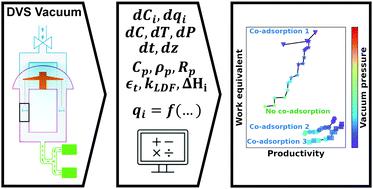当前位置:
X-MOL 学术
›
Energy Environ. Sci.
›
论文详情
Our official English website, www.x-mol.net, welcomes your
feedback! (Note: you will need to create a separate account there.)
The impact of binary water–CO2 isotherm models on the optimal performance of sorbent-based direct air capture processes
Energy & Environmental Science ( IF 32.4 ) Pub Date : 2021-08-02 , DOI: 10.1039/d1ee01272j John Young 1, 2, 3, 4 , Enrique García-Díez 1, 2, 3, 4 , Susana Garcia 1, 2, 3, 4 , Mijndert van der Spek 1, 2, 3, 4
Energy & Environmental Science ( IF 32.4 ) Pub Date : 2021-08-02 , DOI: 10.1039/d1ee01272j John Young 1, 2, 3, 4 , Enrique García-Díez 1, 2, 3, 4 , Susana Garcia 1, 2, 3, 4 , Mijndert van der Spek 1, 2, 3, 4
Affiliation

|
Direct air capture (DAC) is an auspicious technology in pursuing negative CO2 emissions. A promising process is temperature vacuum swing adsorption (TVSA) employing amine functionalised adsorbents such as Lewatit® VP OC 1065, which is selected as a benchmark sorbent in this study. To further improve process design, and critically lower costs, detailed modelling of DAC cycles is imperative. However, the multi-component adsorption on these materials, particularly the cooperative adsorption of CO2 and H2O, is crudely understood, and yet to be described in mathematical terms, prohibiting sound modelling efforts. Here, we commit in-depth understanding of the effect of humidity on CO2 adsorption and demonstrate how this impacts modelling of DAC cycles. We present two novel mechanistic co-adsorption isotherm models to describe water's effect on CO2 adsorption and find a good fit to original experimental co-adsorption data. We also show the considerable improvement in predictions of these models when compared to an empirical co-adsorption isotherm model from literature. A detailed TVSA DAC cycle process model is then used elucidating how different co-adsorption models affect the predicted process performance. It is found that the two novel isotherm models generate similar results and Pareto fronts, whilst the minimum work equivalent calculated using the more conservative of the two models is found to be 2.49 MJ kg−1 for the case study considered. These mathematical descriptions laid out will lead to more accurate modelling and optimisation of cyclic DAC adsorption processes, prompting a greater understanding of the material-process combinations ideal for DAC and how costs can be driven down in the years to come. Importantly, they allowed us to independently benchmark a Climeworks type DAC process, providing key DAC performance data to the public domain.
中文翻译:

二元水-CO2 等温线模型对基于吸附剂的直接空气捕获过程的最佳性能的影响
直接空气捕获 (DAC) 是追求负 CO 2排放的一项吉祥技术。一个有前景的工艺是变温真空吸附 (TVSA),它采用胺功能化吸附剂,如 Lewatit® VP OC 1065,在本研究中被选为基准吸附剂。为了进一步改进工艺设计并大幅降低成本,DAC 周期的详细建模势在必行。然而,对这些材料的多组分吸附,特别是 CO 2和 H 2 O的协同吸附,尚不明确,尚待用数学术语进行描述,从而阻碍了合理的建模工作。在这里,我们深入了解湿度对 CO 2 的影响吸附并演示这如何影响 DAC 循环的建模。我们提出了两种新的机械共吸附等温线模型来描述水对 CO 2吸附的影响,并找到与原始实验共吸附数据的良好拟合。与文献中的经验共吸附等温线模型相比,我们还展示了这些模型的预测显着改进。然后使用详细的 TVSA DAC 循环过程模型阐明不同的共吸附模型如何影响预测的过程性能。发现两个新的等温线模型产生相似的结果和帕累托前沿,而使用两个模型中更保守的模型计算的最小功当量为 2.49 MJ kg -1对于所考虑的案例研究。这些数学描述将导致对循环 DAC 吸附过程进行更准确的建模和优化,促使人们更深入地了解 DAC 的理想材料工艺组合,以及如何在未来几年降低成本。重要的是,它们使我们能够独立地对 Climeworks 类型的 DAC 过程进行基准测试,向公共领域提供关键的 DAC 性能数据。
更新日期:2021-08-09
中文翻译:

二元水-CO2 等温线模型对基于吸附剂的直接空气捕获过程的最佳性能的影响
直接空气捕获 (DAC) 是追求负 CO 2排放的一项吉祥技术。一个有前景的工艺是变温真空吸附 (TVSA),它采用胺功能化吸附剂,如 Lewatit® VP OC 1065,在本研究中被选为基准吸附剂。为了进一步改进工艺设计并大幅降低成本,DAC 周期的详细建模势在必行。然而,对这些材料的多组分吸附,特别是 CO 2和 H 2 O的协同吸附,尚不明确,尚待用数学术语进行描述,从而阻碍了合理的建模工作。在这里,我们深入了解湿度对 CO 2 的影响吸附并演示这如何影响 DAC 循环的建模。我们提出了两种新的机械共吸附等温线模型来描述水对 CO 2吸附的影响,并找到与原始实验共吸附数据的良好拟合。与文献中的经验共吸附等温线模型相比,我们还展示了这些模型的预测显着改进。然后使用详细的 TVSA DAC 循环过程模型阐明不同的共吸附模型如何影响预测的过程性能。发现两个新的等温线模型产生相似的结果和帕累托前沿,而使用两个模型中更保守的模型计算的最小功当量为 2.49 MJ kg -1对于所考虑的案例研究。这些数学描述将导致对循环 DAC 吸附过程进行更准确的建模和优化,促使人们更深入地了解 DAC 的理想材料工艺组合,以及如何在未来几年降低成本。重要的是,它们使我们能够独立地对 Climeworks 类型的 DAC 过程进行基准测试,向公共领域提供关键的 DAC 性能数据。










































 京公网安备 11010802027423号
京公网安备 11010802027423号